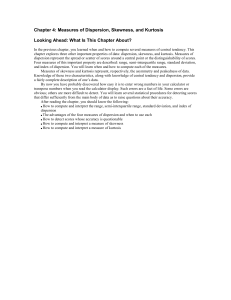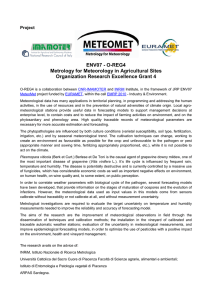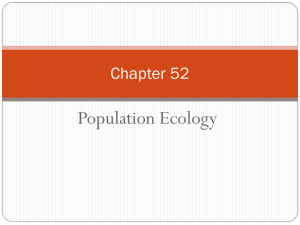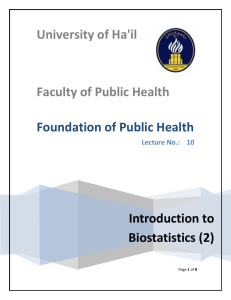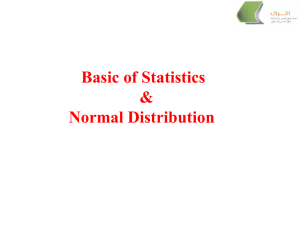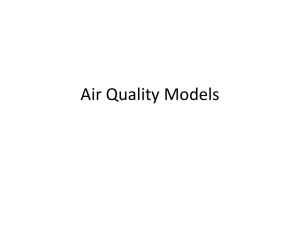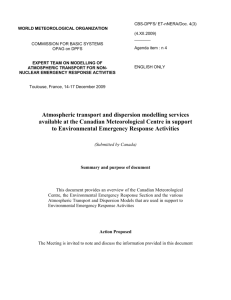3(2) - WMO
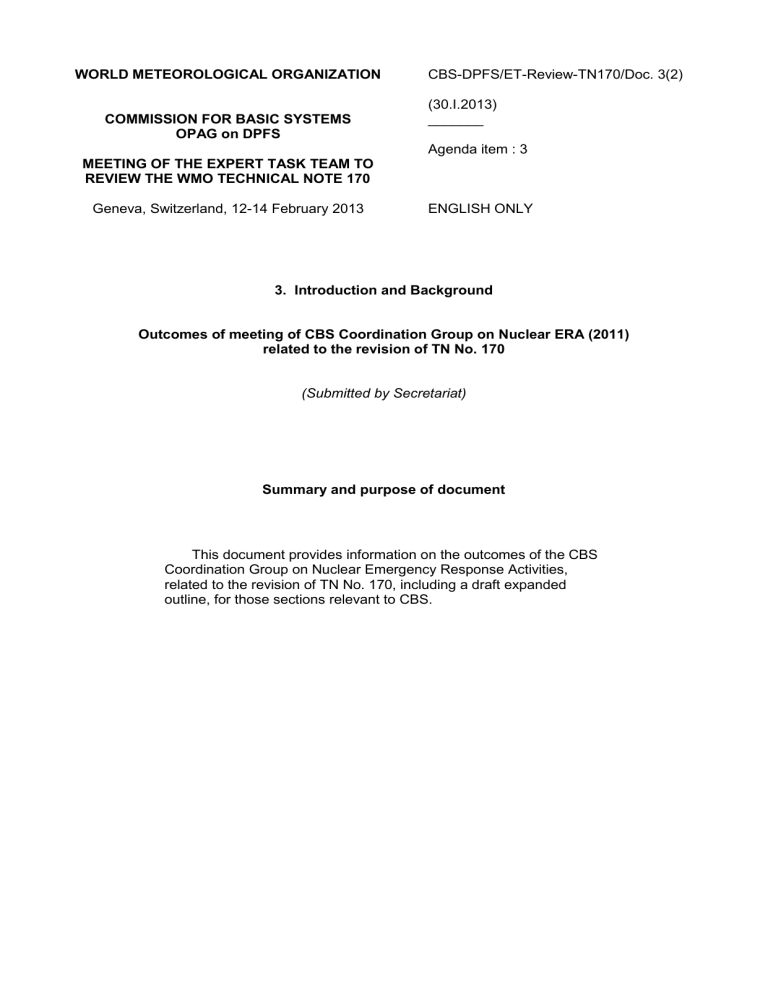
WORLD METEOROLOGICAL ORGANIZATION
COMMISSION FOR BASIC SYSTEMS
OPAG on DPFS
MEETING OF THE EXPERT TASK TEAM TO
REVIEW THE WMO TECHNICAL NOTE 170
Geneva, Switzerland, 12-14 February 2013
CBS-DPFS/ET-Review-TN170/Doc. 3(2)
(30.I.2013)
_______
Agenda item : 3
ENGLISH ONLY
3. Introduction and Background
Outcomes of meeting of CBS Coordination Group on Nuclear ERA (2011) related to the revision of TN No. 170
(Submitted by Secretariat)
Summary and purpose of document
This document provides information on the outcomes of the CBS
Coordination Group on Nuclear Emergency Response Activities, related to the revision of TN No. 170, including a draft expanded outline, for those sections relevant to CBS.
CBS-DPFS/ET-Review-TN170/Doc. 3(2), p. 2
Excerpt of report of
CBS Coordination Group on Nuclear Emergency Response Activities
31 October – 4 November 2011
Vienna, Austria
…
10. STATUS OF REVIEW OF WMO/TN 170 ON “METEOROLOGICAL AND HYDROLOGICAL
ASPECTS OF SITING AND OPERATIONS OF NUCLEAR POWER PLANTS”
10.1 The meeting noted the successful collaboration of WMO with the IAEA on the development of a new IAEA Safety Guide, entitled: “Meteorological and Hydrological Hazards in Site Evaluation of Nuclear Installations” (IAEA/DS-No. 417), which represented an important first step to the review requested by the World Meteorological Congress, in its fifteenth session (May 2007), of the outdated WMO Technical Note 170, entitled: “Meteorological and Hydrological Aspects of Siting and Operations of Nuclear Power Plants”. This Safety Guide will act as an important guide to essential subject areas where technical methods and best practices should be updated in the revision of the WMO Technical Note.
10.2 The meeting noted that only a few sections of the publication concern CBS, and several
WMO programmes and technical commissions should be involved in updating the Technical Note.
Following a throughout review of the relevant sections (Chapter 2, entitled Practical guidance for meteorologists in charge of the meteorological assessments and continuing services; section 2.2.4
– normal NPP operation, and 2.2.5 – NPP emergency situations), the meeting developed a proposed expanded outline for updating these sections, which it provided in Annex IV.
N.B.
IAEA Safety Guide : “Meteorological and Hydrological Hazards in Site Evaluation of Nuclear
Installations” (IAEA/DS-No. 417) has been published in 2011, and jointly sponsored by IAEA and
WMO, under the series Specific Safety Guide (No. SSG-18). This volume is available through the
IAEA Publications Website: http://www-pub.iaea.org/books/iaeabooks/8635/Meteorological-and-
Hydrological-Hazards-in-Site-Evaluation-for-Nuclear-Installations-Specific-Safety-Guide
ANNEX IV
WMO/TN-No. 170
– PROPOSED EXTENDED OUTLINE FOR UPDATING
SECTIONS 2.2.4 AND 2.2.5
Considering Atmospheric Dispersion for Nuclear Power Plant Siting and Operations
Abstract: The atmospheric planetary boundary layer (PBL) height and winds and temperature in the boundary layer are critical weather components that drive dispersion decision support tools to assess contaminant concentration at a particular location. Therefore, accurate assessment of complex boundary layer processes at finer scales should improve a nuclear power plant operator’s ability to assess the effects of a potential toxic release. Three dimensional dispersion models coupled with high resolution meteorological model can now be used to provide improved estimate of the temporal and spatial structure of the PBL and a plume dispersion assessment forecast models to protect life and property.
1. Introduction
The atmospheric planetary boundary layer (PBL) height and winds and temperature in the boundary layer are critical weather components that drive dispersion decision support tools to assess contaminant concentration at a particular location. Numerous studies have shown model concentrations to be very sensitive to boundary layer information. For example, Hanna (1984) showed that doubling the PBL height led to a reduction in plume concentrations by a factor of two.
Therefore, small errors in boundary layer heights can lead to large errors in plume concentration forecasts.
Therefore, accurate assessment of complex boundary layer processes at finer scales should improve a nuclear power plant operator’s ability to assess the effects of a potential toxic release.
The goal of this paper is to provide re commendations on improving an emergency manager’s assessment and response to a potential release of toxic materials form a nuclear power plant to the atmosphere. New methods are now available to better capture important atmospheric boundary layer processes that influence the toxic plume dispersion are summarized. The following recommendations are made to improve these assessments:
Basic weather and atmospheric turbulence monitoring to capture atmospheric planetary boundary layer processes derived from surface and upper level instruments.
Integrating these observations into a retrospective or Real Time Mesoscale weather
Analysis (RTMA) around the site through recent downscaling technologies (described in section XX). A planetary boundary layer (PBL) analysis can be created by ingesting on-site or nearby surface mesonets and upper level ACARS, profiler or lidar measurements through dynamic or statistical downscaling. Adequate meteorological analyses may also be obtained through the regional NMC who may already run higher horizontal resolution (~
4km) weather analysis and forecast models. Typically high resolution vertical resolution
(50-100 m) meteorological fields are also desired to accurately resolve boundary layer information.
Outputting important meteorological parameters from the analysis including: o Surface and boundary layer winds, temperature, moisture, pressure o Mixed layer depth o Precipitation
Also useful would be: o Cloud fraction, base and heights. o Surface momentum, heat and moisture fluxes o Estimates of mixed layer turbulence (e.g: turbulent kinetic energy, energy dissipation rates…) and stability. o
Regular verification of basic meteorological downscaled predictions would be performed to determine strength and weaknesses of the modeling system that could be conveyed to the model developer or modeling center where the predictions were performed.
Utilizing these analyses and forecasts to drive an Atmospheric Transport and Diffusion
Model (ATM) to produce surface estimates of realistic toxic concentrations if source term estimates are know. Otherwise relative concentration factors (X/Q) would be produced to help emergency managers identify areas conducive for weak dispersion (stable atmospheric conditions) that would be particularly vulnerable to high toxic pollutant concentrations if a release did occur.
Using the emergency response dispersion capability for power plant siting evaluations by conducting an assessment of areas vulnerable to higher concentrations from atmospheric dispersion processes. Guidelines for producing a dispersion assessment are suggested in section XX.
2. Background
2.1. Previous reports on assessing dispersion for site planning or operations
• TN 170:
– Assessment of flow characteristic when evaluating NPP Siting.
– What and how to respond After a release has occurred.
–
• IAEA Doc 3-2
– The atmosphere is a major exposure pathway by which radioactive materials that are either routinely discharged under authorization or accidentally released from a nuclear power plant could be dispersed in the environment and transported to locations where they may reach the public.
– The evaluation of the transport in the atmosphere of radioactive materials discharged from a nuclear power plant under normal operational or accidental conditions is a requirement of design and licensing (Ref. [2], para. 503). A meteorological investigation should be carried out to evaluate regional and site specific meteorological parameters. These data should be collected from appropriate elevations above ground in order to obtain realistic dispersion parameters.
– Contamination in the air, on the ground and in water over short and long time periods should be described in the atmospheric dispersion models, with account taken of diffusion conditions in the region. Orographic elevations having significant slopes should be considered in the models.
– The type and extent of acquired and stored meteorological data should allow for reliable statistical analyses to determine the distribution of radiation exposures.
– The effects and consequences for the public and the environment of short term or long term radioactive discharges should be assessed on the basis of meteorological information and site specific conditions relating to land and water uses, population distribution, infrastructure in the vicinity of the site and relevant radiological parameters.
– A detailed meteorological investigation should be carried out in the region. The calculations of the dispersion and concentrations of radioactive materials should show whether the radiological consequences of routine discharges and potential accidental releases of radioactive materials into the atmosphere are acceptable.
The results of these calculations may be used to establish authorized limits for radioactive discharges from the plant into the atmosphere (see Ref. [5]).
– The results of the meteorological investigation should be used to confirm the suitability of a site; to provide a baseline for site evaluation; to determine whether local meteorological characteristics have altered since the site evaluation was made and before operation of the plant commences; to select appropriate dispersion models for the site; to establish limits for radioactive discharges into the atmosphere; to establish limits for design performance (for example, containment leak rates and control room habitability); and to assist in demonstrating the feasibility of an emergency plan.
• IAEA Doc. 417 : Most of the focus are on Meteorological and Hydrological Events that may trigger a release.
– No consideration of likelihoods of population centers being affected after a release by typical flow patterns.
– Mention of the need for a warning system after a release (Chap. 9)
• The warning system should be used in connection with forecasting models since the time period that would be necessary for operator actions to put the installation into a safe status may necessitate acting on the basis of extrapolations of trends in phenomena without waiting for the actual occurrence of the hazardous event.
2.2. local-scale meteorological processes that influence atmospheric dispersion
2.1.1 Mountain-Valley winds
2.1.2 Sea and ake breeze
2.1.3 Urban Heat Island
3. Methods for creating a representative atmospheric dispersion analysis and forecast system.
3.1. Prototype Dispersion Analysis and Forecast System
Recognizing the amount of effort needed to develop a thoroughly tested and validated dispersion analysis and forecasting system, this document recommends a range of capabilities.
Configuration of the U.S. NWS boundary layer analysis system is illustrated below. The RTMA is executed at high resolution (5 km) for the CONUS. Time continuous 3-D distributions of boundary layer) products, calibrated by measurements, are linked to the operational systems.
Prototype Configuration
NCEP Real Time Mesoscale Analysis
Cycle N Cycle N+1
+1 Hr
Analysis Analysis
Repeat as previous cycle
DATA 9-hr NAM run
48 h HYSPLIT
Forecasts
ESMF Coupler
+ Sonde /ACARS measurements
Figure 1.
Overview of prototype configuration for RTMA boundary layer analyses using GPS RO and other profile measurements. The analysis can be used to drive NOAA’s plume dispersion forecast tool, HYSPLIT.
4. Data collection for an atmospheric boundary layer observation network
4.1. Surface mesonets and mult-level towers
4.2. Nearby Radiosondes and Aircraft profiles
4.3. On-site or nearby boundary layer profilers, sodars and rass data
4.4. Nearby Lidar Measurements
Lidar data such as the NASA Micro-Pulse Lidar Network (MPLNET) ( Welton et al ., 2001) Micro-
Pulse Lidar (MPL) systems are designed to measure aerosol and cloud vertical structure continuously, day and night, over long time periods required to contribute to climate change studies and provide ground validation for models and satellite sensors in the NASA Earth Observing
System (EOS). Figure 7 shows locations of MPLNET sites and various field campaigns, and planned and proposed future sites. The MPLNET website, http://mplnet.gsfc.nasa.gov, provides up-to-date information on the project and access to data products.
Figure XX shows an example of Level 1 lidar profiles from the MPLNET site at NASA Goddard
Space Flight Center in Maryland on May 3, 2001. Sunrise occurs around 13:00 UTC, and PBL growth during morning into afternoon is visible in the figure. Aerosol layers in the free troposphere are visible during the previous night, and the PBL eventually reaches high enough to entrain the material in the afternoon. Entrainment of transported material by the local PBL is directly impact surface concentration measurements. MPLNET collect data continuously, day and night.
5. Creating a Mesoscale Analysis
A region’s NMC may produce high resolution analysis and prediction system that can be leverage to to capture local-scale flows around an NPP. Otherwise, several downscaling techniques may be employed from diagnostic statistical techniques to running a mesoscale numerical analysis and
prediction systems. Observations collected in section 3 would be used to produce these retrospective or real-time analyses.
5.1. Diagnostic Mass Consistent Wind field Analyses.
Surface winds are interpolated to a regular grid
Inverse distance-squared weighting (Goodin et al. 1979)
Inverse elevation difference weighting (Palomino and Martin 1995)
Upper-level wind data are interpolated to the three-dimensional grid
Topographic effects, slope winds and blocking are parameterized (e.g.: CALMET).
The three-dimensional wind fields are adjusted to ensure the conservation of mass
(Moussiopoulos and Flassak 1986; Brocchini et al. 1995)
5.1.1. Examples (CALMET)
• Uses coarse-grid input of meteorological fields, and makes adjustments to wind field based on coarse versus fine-grid terrain and land use fields
•
•
Forces flow to be terrain-parallel, modulated by stability
Requires along-terrain flow where Froude number < 1
• Removes the consequent 3D divergence with an iterative procedure
• Makes adjustments for underlying roughness using similarity theory
CALMET downscaled winds (550 m resolution)over the central PA valley
5.2. Combined Physical and Statistical Downscaling ( A. Jacobs, KNMI)
• Based on a simple model of the Planetary Boundary-Layer and on high-resolution surface
© 2010 3TIER, Inc. roughness information.
• The PBL model consists of two layers:
– the Ekman layer
– the surface layer
• Roughness lengths determined by averaging geographical variations in surface roughness over the upstream area of the airflow.
• The resulting high-resolution roughness lengths are wind direction dependent .
5.3. Uncoupled high resolution land surface model (Canada)
• External high- resolution prognostic surface model driven from regional model
• Interactions between Surface, Biosphere, and Atmosphere (ISBA) land surface scheme integrated on a 100m grid (140 km × 180 km)
• Define local land characteristics.
– microscale topo- graphic information from the Shuttle Radar Topography Mission
Digital Elevation Model (SRTM-DEM).
– GlobCover global data- base at 300 m and several Canadian databases.
• Down-scale driving atmospheric forcing (i.e. temperature, humidity, winds, surface pressure, downwelling shortwave and longwave radiation, and precipitation)
– height difference between the high-resolution (100 m) grid and the low-resolution atmospheric forcing grid,
– assume a constant lapse rate of 0.0060 K m−1 to adjust to high res. elevation
– downscale surface pressure and temperature.
– downscale low-level air humidity, by assuming conservation of relative humidity, and to possibly change precipitation phase
• Initial conditions of surface variables (e.g., snow surface temperature, snow depth, etc.) from the 24-h external microscale forecast of the previous day.
5.4. Variational Assimilation (RTMA)
Two components of the Real-Time Mesoscale Analysis (RTMA) run in the NCEP production suite on the NOAA Central Computer System (CCS). These two components of the RTMA system are developed and supported by the Environmental Modeling Center (EMC) and operated and managed by NCEP Central Operations (NCO). RTMA products were introduced on the National
Weather Service’s Advanced Weather Information Processing System (AWIPS) in 2006.
The RTMA suite of analyses comes from three sources with two running at NCEP. An Effective
Cloud Amount (ECA) is produced from GOES data at and by NOAA/NESDIS. An hourly analysis of gage observations and radar estimates of precipitation accumulation over the contiguous United
States (CONUS) is produced at NCEP and is called the Stage II National Precipitation Analysis.
For the RTMA, this analysis is converted and interpolated to the 5 km NWS National Digital
Forecast Database (NDFD grid) used by all NWS Forecast offices to produce gridded forecast products
The primary RTMA system component, is based on a 2dimensional application of EMC’s unified
3-dimensional variational analysis system called Grid-point Statistical Interpolation (GSI). The GSI runs in both the North American Mesoscale (NAM & NDAS) and Global Forecast System (GFS &
GDAS). Using a first-guess obtained by downscaling a 1-hour Rapid Update Cycle (RUC) forecast from 13- to 5-km, the RTMA performs an analysis of all surface observations (surface-synoptic, metar, mesonet, ship, buoy etc) of temperature and dew point at 2 m and wind at 10 m. In addition, estimates of analysis uncertainty for each variable are also produced. Reducing the assimilation process to two dimensions enables the development of high resolution analysis in real-time for various forecaster applications. A high horizontal resolution analysis is essential for dispersion and air quality applications which are very sensitive to fine scale boundary layer processes driven by fine scale orogrophy such as land-sea breezes, flows in complex terrain and urban heat island effects.
6. Dispersion models for creating concentration analyses and forecasts
These high resolution meteorological analysis would then be used in an atmospheric dispersion model to account for atmospheric turbulence and stability for relatively turbulent, convective or unstable and conditions where less turbulence and a more stable atmosphere exists. Atmospheric stability can have a large effect on the predicted or analyzed plume footprint or concentration amount. Under unstable conditions, for example, a dispersing gas will mix rapidly with the air around it. The plume cloud will extend less far downwind than it would under more stable conditions, because the pollutant would more be diluted faster.
Several types of dispersion models are used as part of the WMO EER RSMC capability.
As a result of the poor communications between countries following the Chernobyl accident in the
Spring of 1986, the World Meteorological Organization (WMO) was asked by the International
Atomic Energy Agency (IAEA) and other international organizations to arrange for early warning messages about nuclear accidents to be transmitted over the Global Tele-communications System
(GTS). In addition some WMO member countries lacking extensive forecasting capability requested that specialized pollutant transport and dispersion forecasts be provided during these emergencies.
In 1989, Regional Specialized Meteorological Centers at Toulouse (Meteo-France), Bracknell and
Montreal were set up under interim arrangements between the WMO and the IAEA. Under these arrangements Meteo-France was to provide global coverage (with Bracknell as the backup center) until each WMO region had at least two RSMCs for transport model products.
6.1. RSMC-Washington Dispersion Model Capability
The HYSPLIT (HYbrid Single-Particle Lagrangian Integrated Trajectory) model is the newest version of a complete system for computing simple air parcel trajectories to complex dispersion and deposition simulations. It is the primary NOAA decision support tool for plume dispersion and
RSMC support. The dispersion of a pollutant is calculated by assuming either puff or particle dispersion. In the puff model, puffs expand until they exceed the size of the meteorological grid cell
(either horizontally or vertically) and then split into several new puffs, each with it's share of the pollutant mass. In the particle model, a fixed number of initial particles are advected about the model domain by the mean wind field and a turbulent component. The model's default configuration assumes a puff distribution in the horizontal and particle dispersion in the vertical direction. In this way, the greater accuracy of the vertical dispersion parameterization of the particle model is combined with the advantage of having an ever expanding number of particles represent the pollutant distribution.
.
6.2. RSMC-Toulouse
6.3. RSMC-Canada
6.4. RSMC-Austria
6.5. RSMC-Offenbach
6.6. RSMC-Obninsk
6.7. …
7. Creating a Dispersion Climatology for assessing Power Plant release impacts
7.1. Dispersion model analysis guidelines
7.1.1. Annual simulations
7.1.2. Create gridded summary statistics.
7.1.2.1. Mean, Variance, probability of threshold exceedance
P r r o b a b i i l l i i s t t i i c C a l l c u l l a t t i i o n s
7.1.2.2. Clustering to represent different scenarios
REFERENCES
Parrish, D. F. and J. C. Derber, 1992: The National Meteorological Center's spectral statistical interpolation analysis system., Mon. Wea. Rev ., 120 , 1747 - 1763.
Tsidulko, M., G. Dimego, M. Ek, J. McQueen, and P. C. Lee: PBL and ozone verification in NAM-
CMAQ modeling system at NCEP, 9th Conference on Atmospheric Chemistry, San Antonio,
TX, 14-18 January, 2007.
Welton, E. J., J. R. Campbell, J. D. Spinhirne, and V. S. Scott, 2001: Global monitoring of clouds and aerosols using a network of micro-pulse lidar systems, in Lidar Remote Sensing for
Industry and Environmental Monitoring, U. N. Singh, T. Itabe, N. Sugimoto, (eds.), Proc. SPIE,
4153, 151-158.
Winker, D. M., J. R. Pelon, and M. P. McCormick, 2002: The CALIPSO mission: spaceborne lidar for observation of aerosols and clouds. in Lidar Remote Sensing for Industry and
Environmental Monitoring III, U. N. Singh, T. Itabe, Z. Liu, (eds.), Proc. SPIE, 4893, 1-11.
Wu, W.-S., R. J. Purser, and D. F. Parrish, 2002: Three-dimensional variational analysis with spatially inhomogeneous covairances, Mon. Wea. Rev ., 130 , 2905-2916.
L.R. Bishnoi and Prabir C. Basu, “Siting of Nuclear Installations”, Nuclear India, Vol 38, No.7-8,
Page 8-10, Jan-Feb. 2005.
ATOMIC ENERGY REGULATORY BOARD, AERB/SC/S, “Code of Practice on Safety in Nuclear
Power Plant Siting”, 1990.
IAEA SAFETY STANDARDS SERIES, NS-R3, “Site Evaluation for Nuclear Installations”, 2003.
INTERNATIONAL ATOMIC ENERGY AGENCY, Meteorological Events in Site Evaluation for
Nuclear Power Plants, Safety Standards Series No. NS-G-3.4, IAEA, Vienna (2003).
INTERNATIONAL ATOMIC ENERGY AGENCY, Dispersion of Radioactive Material in Air and
Water and Consideration of Population Distribution in Site Evaluation for Nuclear Power
Plants, Safety Standards Series No. NS-G-3.2, IAEA, Vienna (2002).
INTERNATIONAL ATOMIC ENERGY AGENCY, Flood Hazard for Nuclear Power Plants on
Coastal and River Sites, Safety Standards Series No. NS-G-3, IAEA, Vienna 2003.


